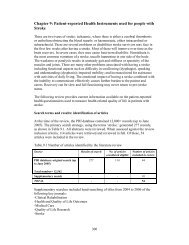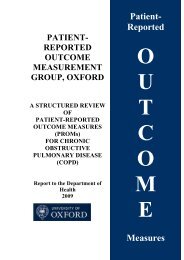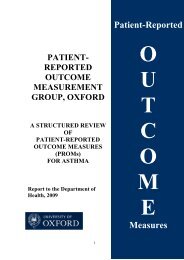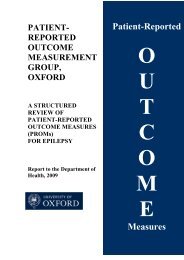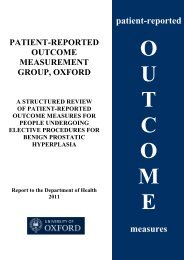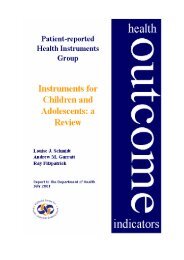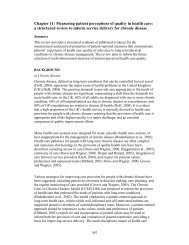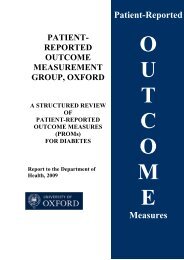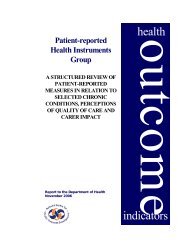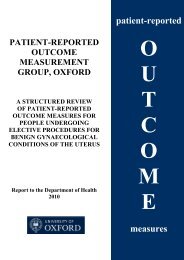2010 review - Patient-Reported Outcomes Measurement - University ...
2010 review - Patient-Reported Outcomes Measurement - University ...
2010 review - Patient-Reported Outcomes Measurement - University ...
Create successful ePaper yourself
Turn your PDF publications into a flip-book with our unique Google optimized e-Paper software.
egarding the criterion for measuring change: whether a five- or a ten-point change be<br />
considered the standard? A clinically important score change might not be statistically<br />
significant, and vice versa.<br />
The length of the SF-36 was felt to be a significant limitation. In light of this, whilst<br />
acknowledging that it is the weaker instrument, two members of the panel suggested that the<br />
SF-12 might be more acceptable. The other major disadvantage of the SF-36 noted by the<br />
group was the cost of licensing.<br />
EQ-5D<br />
Amongst the advantages of this measure the group noted its applicability in cost-effectiveness<br />
analysis, and the fact that scores can be benchmarked with results for the general population.<br />
It was felt to have good evidence based on the <strong>review</strong>, although not all members of the group<br />
were familiar with its use. One member considered it their preferred generic instrument.<br />
Another was aware of unpublished evidence supporting good discrimination of the measure<br />
in ECRP. The EQ-5D was felt to be short and simple to complete, and apparently acceptable<br />
to patients.<br />
On the other hand, one panel member noted the poor completion rates reported in several<br />
studies, suggesting that it is not universally acceptable to patients. Another felt that the<br />
simplicity of the instrument was also its weakness, with the limited range of questions and<br />
response options rendering it insensitive to all but gross change, and likelihood of ceiling<br />
effects. Low reliability of the VAS thermometer was noted.<br />
Generic total<br />
RATING ‘not at all<br />
suitable’<br />
(score 0)<br />
‘to some<br />
extent<br />
unsuitable’<br />
(score 1)<br />
‘uncertain’<br />
(score 2)<br />
Specific PROMs<br />
SAQ<br />
This instrument was regarded as useful for follow-up studies. It was considered to have<br />
robust characteristics and, given its widespread use in ECRP, to allow for meaningful<br />
comparisons to be made. Members of the group noted the measure’s good face validity and<br />
sensitivity to change, with a wide range of response options.<br />
Uncertainties expressed by the panel included whether clinically relevant differences in<br />
subscale scores had been established. Given the focus on angina, the measure might not be<br />
sufficiently responsive to improvements in dyspnoea or fatigue. It was also noted that<br />
published studies did not always clarify which domains of the instrument had been used.<br />
The group’s main criticism of the SAQ was regarding the measure’s limited content. It was<br />
felt to be heavily weighted towards physical symptoms, and unable fully to capture emotional<br />
or cognitive changes. It was also inappropriate for evaluating ECRP carried out for<br />
prognostic purposes.<br />
49<br />
‘to some<br />
extent<br />
suitable’<br />
(score 3)<br />
‘very<br />
suitable’<br />
(score 4)<br />
TOTAL<br />
SF-36 0 - - 9 8 17<br />
EQ-5D 0 1 - - 16 17



